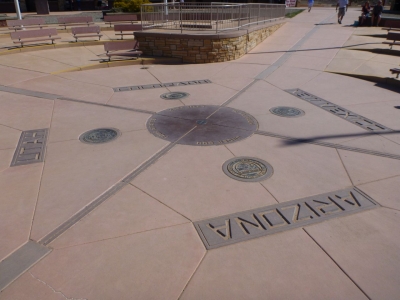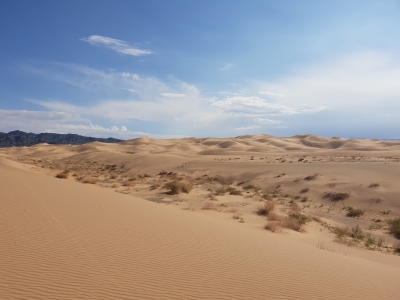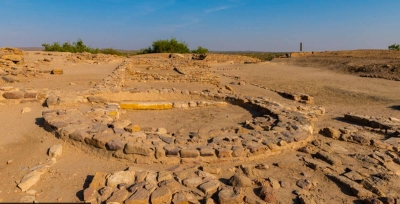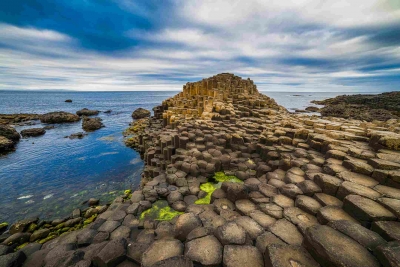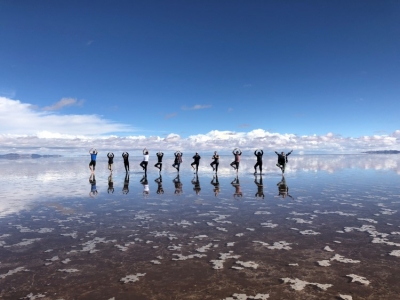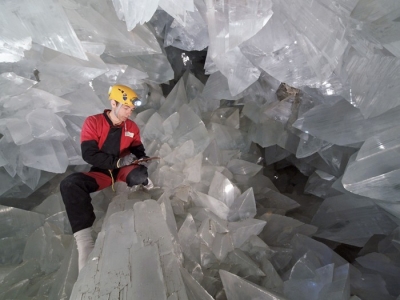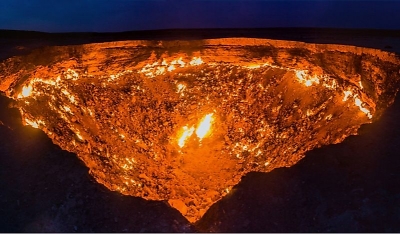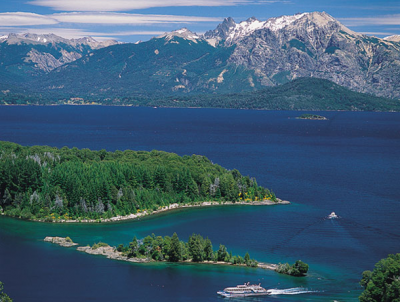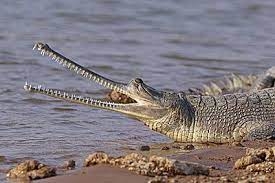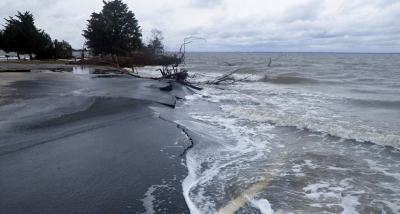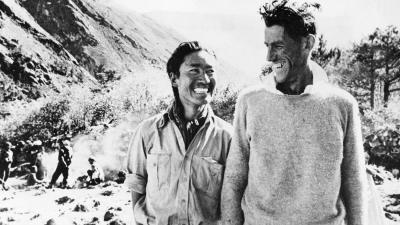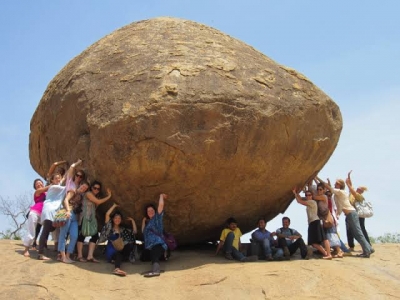
Sikkim borders the Tibet Autonomous Region of China in the north and northeast, Bhutan in the east, Nepal in the west, and West Bengal in the south. Sikkim is also close to India's Siliguri Corridor near Bangladesh. The Tibetan name for Sikkim is Drenjong (Wylie-translation: bras ljongs), meaning "Valley of Rice", while the Bhutias call it Beyul Demazong, meaning "the Hidden Valley of Rice". According to folklore, after establishing Rabdentse as his new capital, Bhutia king Tensung Namgyal built a palace and asked his Limbu Queen to name it. The Lepcha people, the original inhabitants of Sikkim, called it Nye-mae-el, meaning "paradise".
History
The Lepchas are considered to be the earliest inhabitants of Sikkim. However, the Limbus and the Magars also lived in the inaccessible parts of West and South districts as early as the Lepchas lived in the East and North districts. The Buddhist saint Padmasambhava, also known as Guru Rinpoche, is said to have passed through the land in the 8th century. The Guru is reported to have blessed the land, introduced Buddhism, and foretold the era of monarchy that would arrive in Sikkim centuries later,
In 1975, the Prime Minister of Sikkim appealed to the Indian Parliament for Sikkim to become a State of India. In April that year, the Indian Army took over the city of Gangtok and disarmed the Chogyal's palace guards. Thereafter, a referendum was held in which 97.5 per cent of voters supported abolishing the monarchy, effectively approving union with India. On 16 May 1975, Sikkim became the 22nd State of the Indian Union, and the monarchy was abolished. To enable the incorporation of the new State, the Indian Parliament amended the Indian Constitution. The 35th Amendment laid down a set of conditions that made Sikkim an "Associate State", a special designation not used by any other State. Later, the 36th Amendment repealed the 35th amendment, making Sikkim a full State and adding its name to the First Schedule of the Constitution.
Infrastructure
Sikkim's roads are maintained by the Border Roads Organisation (BRO), an offshoot of the Indian Army. The roads in southern Sikkim are in relatively good condition, landslides being less frequent in this region. The State government maintains 1,857 kilometres of roadways that do not come under the BRO's jurisdiction.
On 8 December 2008, Sikkim became the first State in India to achieve 100 per cent sanitation coverage, becoming completely free of public defecation, thus attaining the status of "Nirmal State". The official languages of the state are English, Nepali, Sikkimese (Bhutia) and Lepcha. Additional official languages include Gurung, Limbu, Magar, Mukhia, Newar, Rai, Sherpa and Tamang for the purpose of preservation of culture and tradition in the state. Nepali is the lingua franca of Sikkim, while Sikkimese (Bhutia) and Lepcha are spoken in certain areas. English is spoken and understood in most part of Sikkim.
Education
Sikkim's adult literacy rate is 84.2 per cent: 87.29 per cent for males and 76.43 per cent for females. There are a total of 1,157 schools in the State, including 765 schools run by the State government, seven central government schools and 385 private schools. There is one Institute of National Importance, one central University and four private Universities in Sikkim offering higher education.
Districts
There are four districts in Sikkim, each overseen by a Central Government appointee, the district collector, who is in charge of the civilian areas of these districts. The Indian army has control of a large territory, as the State is a sensitive border area.
The majority of Sikkim's residents are of Nepali ethnic origin. The native Sikkimese consists of the Bhutias, who migrated from the Kham district of Tibet in the 14th century, and the Lepchas, who are believed to pre-date the Bhutias and are the oldest-known inhabitants.
Tibetans reside mostly in the northern and eastern reaches of the state. Migrant resident communities include Bengalis, Biharis and Marwaris, who are prominent in commerce in South Sikkim and Gangtok. Religions in Sikkim (2011) includes Hinduism (57.76%), Buddhism (27.39%), Christianity (9.91%), Islam (1.62%), Sikhism (0.31%), Jainism (0.05%), Others (2.67%).
Flora and fauna
Sikkim is situated in an ecological hotspot of the lower Himalayas, one of the three eco-regions of India. The forested regions of the State exhibit a diverse range of fauna and flora. Owing to its altitudinal gradation, the State has a wide variety of plants, from tropical species to temperate, alpine and tundra ones, and is perhaps one of the few regions to exhibit such diversity within a small area.
Places of tourist interest
Gangtok: The capital city of Sikkim, Gangtok is nestled in the Eastern Himalayas and is one of the kaleidoscopic tourist destinations in the state.
Yuksom: It is the origin of several enthralling treks into the Himalayas or the magical Kanchenjunga. Once a capital of Sikkim, this hamlet is more known for its pristine beauty and rustic appeal.
Tsomgo Lake: Located only 38 kms from Sikkim's capital, it lies at an altitude of 12,400 feet and is one of the highest lakes in India.
Nathula Pass: One of the highest motorable passes in the world, this amazing pass is located at a towering height of 4,310 metres above sea level and connects Sikkim with Tibet.
Pelling: It is from this Sikkimese town that one can have the best view of the Himalayas and the Kanchenjunga Peak.
Lachung: While its location at an enthralling height of 8,610 feet makes it a popular snow-destination in Sikkim, its untouched and surreal beauty makes it one of the scenic and charming tourist places in Sikkim.
Rumtek Monastery: Counted amongst the largest monasteries in Sikkim, it is also one of the oldest monasteries in the State. An ode to the Buddhist culture and traditions, it is located near Gangtok and is also known as the 'Dharma Chakra Centre'.
Namchi: Translated into the native Tibetan language, Namchi means the top of the sky'. Located around 92 kms from Gangtok and at a height of 1,675 metres above sea level, it is one of the most gorgeous cities in the State.
Do-Drul Chorten: The largest stupa in Sikkim, Do Drul Chorten was built in 1945 under the leadership of Truslshi Rimpoche. Holding a high prominence amongst all the religious sites in the State, it is laced with 108 Mani Lhak or prayer wheels and is the ultimate place to connect with the essence of one's inner-self.
Jawaharlal Nehru Botanical Garden: Located in close proximity to the Rumket Monastery, this lush and verdant botanical garden is home to several rare and exotic species of plants and trees. Some of the orchids found in this garden are indigenous to only this part of the world and hold high medicinal and commercial value as well.
Zuluk: Touching a towering height of 10,000 feet, Zuluk is one of the least-discovered destinations in Sikkim. Located on the ancient Silk Route, this Sikkimese village takes pride in being a vintage point to enjoy panoramic views of Mt Kanchenjunga.
Namgyal Institute of Tibetology: Nestled amidst lush and evergreen thickets, the Institute is an ideal centre to learn about Buddhist culture and traditions. Established in 1958, it is home to the largest collection of Tibetan preaching outside Tibet, including relics from the 11th and 12th centuries collected from different parts of the world.
Yumthang Valley: Located at an elevation of 3,500 metres, this scenic valley is home to several exotic, rare and wild flowers. It is often said that one who visits this quintessential valley gets pleasantly affected by its alluring beauty! During the monsoon, the entire valley blooms at its best and displays the most enchanting colours of the nature. Primrose, cobra-lilies, louseworts and cinquefoils are some of the most commonly found species in Yumthang.
Gurudongmar Lake: One of the highest freshwater lakes in the world, this gorgeous place is located at a towering height of 17,800 feet and is also known as Tso Lhsmo Lake.
Festivals of Sikkim
Pang Lhabsol is unique as it celebrates nature. The festival and all its celebrations are surrounding the third highest peak in the world, the Kanchenjunga. Besides celebrating the peak, the festival also honours the treaty signed by the Bhutias and Lepchas where all the local deities were welcomed to witness this occasion.
Rechungma is a typical Sikkimese dance performed to show gratitude to God for his continued blessings. It is usually arranged on occasions like childbirth, marriage and other social gatherings.
Tamang Selo is a Nepali form of dance depicting the Tamangs community. The dance is accompanied by the harmonious tunes of the Damphoo, a musical instrument that the dancers carry in their hands. Owing to it, Tamang Selo is also known as the Damphoo Dance. The dance is performed on occasions like marriages, childbirth and village fairs.
Limboo or Subba Folk Dance is a traditional folk dance of the Sikkimese. The dancers hang the Chyap-brungs, a musical instrument, around their necks. The drum is beaten with a palm on one side and with a stick on the other side. The fancy trick creates two different sounds. The dance comprises of complex footwork that is tuned with the beats of Chyap-Brung.
Yak Chaam and Singhi Chaam are both Tibetan forms of dance. Yak Chaam is a tribute to the yak, an animal on which people rely for survival at high altitudes. Singhi Chaam is another important dance form linked with the five peaks of Mount Kanchunjunga forming an image of the snow lion.
Losoong or Sonam Losar is the Farmer's New Year like the Baisakhi festival of the North where farmers celebrate their bountiful harvest. The lama dancers keep in mind the tradition of expelling of evil spirits and welcoming the New Year.
International Flower Festival: Held in Gangtok in May every year, it is another example of Sikkim's love and respect for nature, Orchids, gladioli, ferns, herbs, roses, cacti, creepers, are all have it on display. The colourful display and the intoxicating fragrance of so many flowers will definitely soothe one's soul.Losar, the Tibetan New Year: The Festival is heralded by the Guthor Chaam that witnesses the lamas of Rumtek and Pemayangtse showcasing the traditional and beautiful dances. Celebrated in February, Gyalpo Losar is about offering flowers to the monasteries, visiting friends and families and hoping for a better year.
Dances of Sikkim
The cultural heritage of Sikkim is expressed in its traditional folk dances, which have become and inseparable part of Sikkim culture. The majority of the dances are associated with the startling beauty of the natural environs. They go together with the tunes of many musical instruments.
Lu Khangthamo is a Bhutia folk dance celebrated to thank all the gods and deities of the three worlds. It is enjoyed by all age groups in their traditional dress and ornaments. It is performed on occasions like house warming, New Year, etc., in the company of pleasing songs and music.
Tamang Selo is a Nepali form of dance performed with the harmonious tunes of "Damphoo', a musical instrument that the dancers carry in their hands. It is also known as 'Damphoo Dance' and is performed on occasions like marriages, childbirth, village fair, etc.
Limboo or Subba is a traditional folk dance of the Sikkimese. The dancers hang the 'Chyap-brungs', a musical instrument around their necks. The drum is beaten with a palm on one side and with a stick on the other side.
Yak Chaam and Singhi Chaam: Both of these are Tibetan forms of dance. Yak Chaam is a tribute to Yak, an animal on which people rely for survival at high altitudes. Singhi Chaam is another important dance form, linked with five peaks of Mount Kanchunjunga forming an image of snow lion, regarded as an important cultural symbol of Sikkim.
Mask Dance is the most famous dance of Sikkim and is almost synonymous with Sikkim. It is divided into various types: Enchey Chaam, Rumtek Chaam and Gouthor Chaam. Gouthor Chaam is performed two days prior to Losar in February. Rumtek Chaam is the most important religious masked dance that is performed on the 10th day of the 5th month of the Tibetan calendar, parallel to the month of June.
Enchey Chaam is performed by lamas and illustrates flawless footwork with grace. Lamas costume themselves with casually painted masks, ritual swords and dazzling jewels. Drums, trumpets and chanting of monks accompany the dancers. It is annually celebrated on the 18th and 19th days of the 11th month of the Tibetan Buddhist Calendar parallel to the months of December January.
Credit : C. Joseph
Picture Credit : Google
